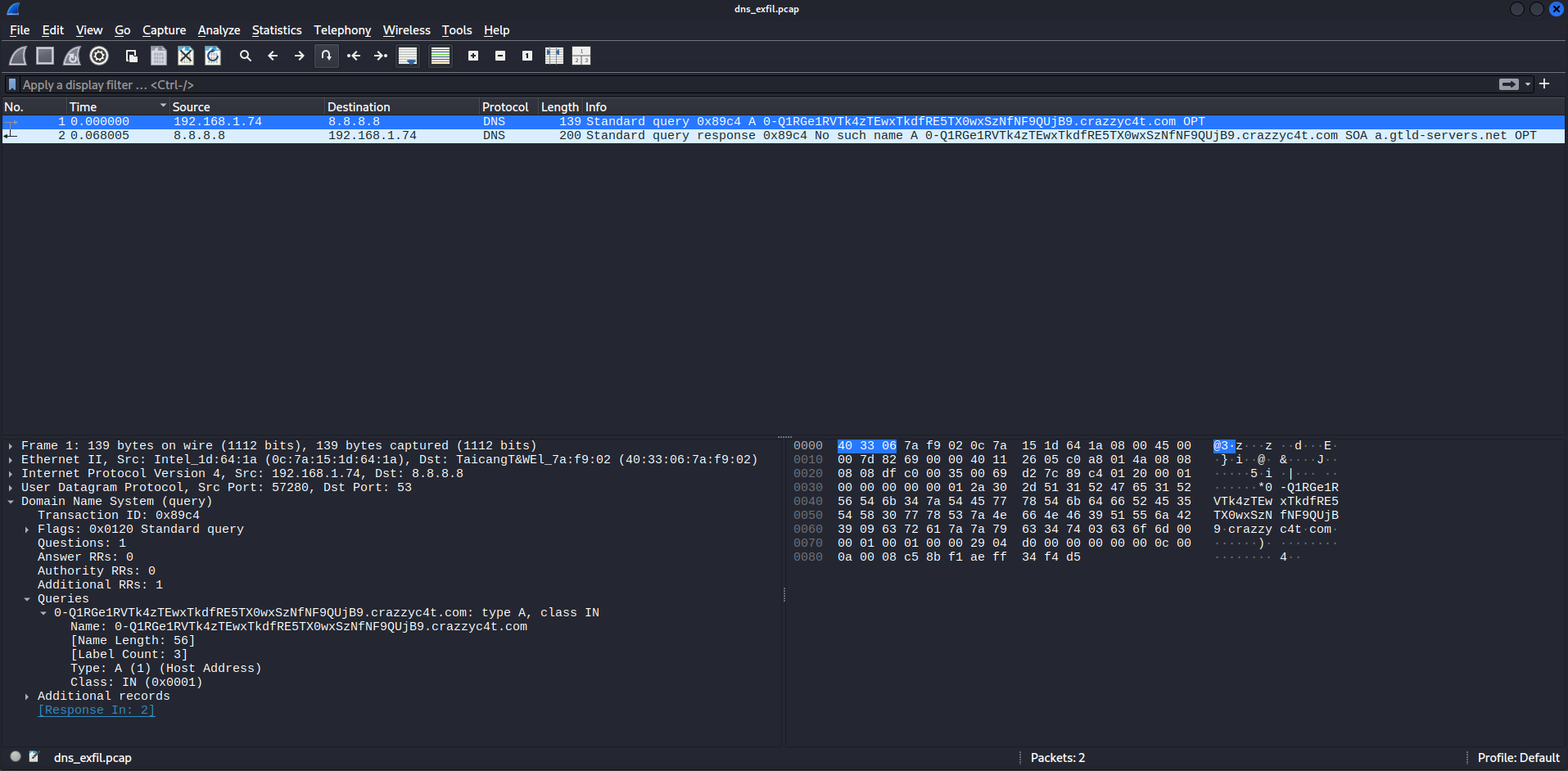DNS Exfiltration
DNS Exfiltration Analysis
Learn more about DNS tunneling detection
Introduction
DNS is a foundational internet protocol used to resolve domain names into IP addresses. However, due to its widespread trust and typically unmonitored nature, DNS is also a prime target for data exfiltration. In DNS tunneling, attackers encode and embed data within DNS queries to bypass firewalls and network monitoring systems.
This post documents the forensic analysis of a network capture file (dns_exfil.pcap) containing suspicious DNS traffic. The objective is to investigate signs of exfiltration, identify the compromised internal host, reconstruct the exfiltrated data, and determine the attacker’s infrastructure to solve ctf challenges.
PCAP Overview
The capture file, dns_exfil.pcap, was analyzed using Wireshark and tshark on a Kali Linux system. The .pcap contains outbound DNS queries from a single internal IP address. The traffic pattern suggests potential data exfiltration via DNS tunneling.
Initial filtering of DNS traffic was done using the following command:
1
tshark -r dns_exfil.pcap -Y "dns.qry.name" -T fields -e dns.qry.name
DNS Query Analysis
The packet capture file dns_exfil.pcap was analyzed using tshark to extract DNS query names. These queries revealed a suspicious pattern involving encoded subdomains, likely used for data exfiltration.
The following command was used to extract all DNS query names from the capture:
1
tshark -r dns_exfil.pcap -Y "dns.qry.name" -T fields -e dns.qry.name > queries.txt
This command reads the dns_exfil.pcap file using -r, applies a display filter -Y to include only DNS queries (dns.qry.name), outputs only the DNS query name field -e dns.qry.name, and saves the output to queries.txt.
To view the extracted DNS queries:
Each query targets the domain crazzyc4t.com, but the subdomain appears to be Base64-encoded. The encoded string Q1RGe1RVTk4zTEwxTkdfRE5TX0wxSzNfNF9QUjB9 is likely the exfiltrated payload embedded within DNS queries.
To decode the string and verify the contents, the following command was executed:
This confirms that the attacker used DNS tunneling to exfiltrate data, embedding a Base64-encoded flag in the subdomain of a DNS query to an external, attacker-controlled domain. This method allows bypassing network monitoring tools that do not deeply inspect DNS payloads.
Identifying the Exfiltrating Host
To determine which machine on the network was responsible for the DNS exfiltration, I inspected the source IP address of the DNS queries sent to the external domain crazzyc4t.com.
Using Wireshark, I examined packet number 1 in the capture. This packet is a standard DNS query requesting the A record for the suspicious domain:
The key information from the packet is:
- Source IP:
192.168.1.74 - Destination IP:
8.8.8.8(Google DNS) - Protocol: DNS (UDP port 53)
- Query Type: A (host address)
This tells us that the machine with IP address 192.168.1.74 is initiating the outbound DNS queries that contain encoded subdomains. The response from 8.8.8.8 confirms that the query occurred and that the name does not resolve which is typical for DNS tunneling payloads sent to a controlled domain.
Therefore, based on the packet details and query behavior, the exfiltrating host is: 192.168.1.74
This IP represents the compromised internal system used by the attacker to tunnel data out of the network via DNS requests.
The ctf is: CTF{TUNN3LL1NG_DNS_L1K3_4_PR0}





